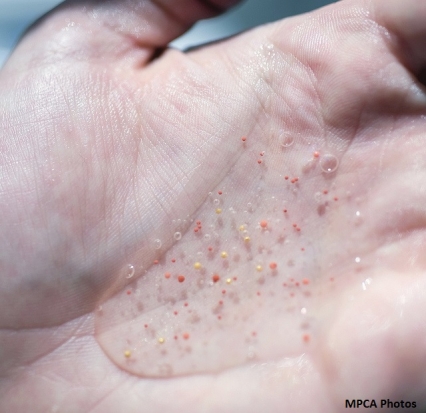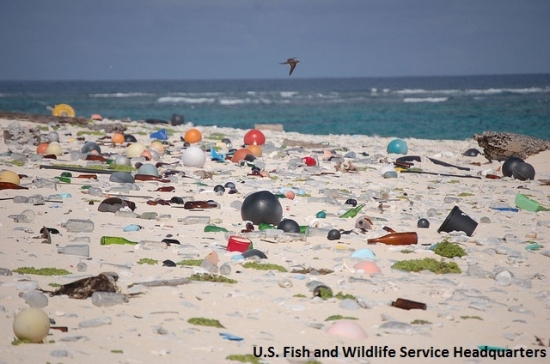By Matt Turley AMRSB, NERC-funded PhD student at the University of Brighton and policy intern at the Royal Society of Biology
 The presence of plastics, particularly microplastics, in the environment has received increasing attention in recent years, with the UK government launching an inquiry last month (closing 15 April). Microplastics are particles of plastic smaller than 5mm, often containing a range of toxic chemicals. They are not new pollutants, but it is only recently that we have begun to understand the scale of the problem. They are introduced to the environment either directly, such as via toiletries or cleaning products, or indirectly via the breakdown of larger plastic products, of which around 300 million tonnes are manufactured globally.
The presence of plastics, particularly microplastics, in the environment has received increasing attention in recent years, with the UK government launching an inquiry last month (closing 15 April). Microplastics are particles of plastic smaller than 5mm, often containing a range of toxic chemicals. They are not new pollutants, but it is only recently that we have begun to understand the scale of the problem. They are introduced to the environment either directly, such as via toiletries or cleaning products, or indirectly via the breakdown of larger plastic products, of which around 300 million tonnes are manufactured globally.
Approximately 80% of microplastics in marine environments come from activities on land. An unexpected source is products such as face and body washes, cosmetics, and cleaning products, which contain plastic microbeads. Add to this the fact that washing a single item of clothing made of synthetic fabric, can release around two thousand plastic fibres per wash, and you begin to see the importance of consumer choices within the home. These microplastics are carried from homes to our wastewater treatment plants, where they either pass through filtering systems and into rivers and the ocean, or settle out in sewage sludge. Approximately 40% of this sludge (within the EU) is used for spreading in agriculture, representing a further pathway to the natural environment. Larger plastic items whilst problematic themselves, are also degraded and broken up by physical and chemical weathering, eventually becoming small enough to be considered microplastics.
 Most research on the impacts of microplastics has focused on marine environments. Here, contaminants in the water can attach to the surface of the plastics, which are in turn ingested by animals. It is thought that the most common reason for ingestion is that plastics are mistaken for food; they can also be passively ingested during feeding or consumed indirectly via prey. Both the plastics and contaminants can accumulate in individual organisms and throughout food webs, with potentially disastrous effects.
Most research on the impacts of microplastics has focused on marine environments. Here, contaminants in the water can attach to the surface of the plastics, which are in turn ingested by animals. It is thought that the most common reason for ingestion is that plastics are mistaken for food; they can also be passively ingested during feeding or consumed indirectly via prey. Both the plastics and contaminants can accumulate in individual organisms and throughout food webs, with potentially disastrous effects.
A study published in January 2016, found that oysters ingested 69% of the microplastics (6 µm) that they were exposed to and had lower reproductive capabilities. Others estimate that 90% of seabirds may have plastics in their gut, giving a stark insight into the extent of the plastic pollution and its presence in the food web.
Tackling the complex problems of microplastic pollution will require numerous policy interventions. The UK and other North-East Atlantic countries agreed a Regional Action Plan, “to substantially reduce marine litter in the OSPAR maritime area to levels where properties and quantities do not cause harm to the marine environment” by 2020 (aligning with EU Marine Strategy aimed at achieving good environmental status). The plans encourage more effective waste prevention and management, education, and outreach, including a voluntary phase-out of microplastics in cosmetic products. This is generally supported by many in the industry, but was criticised by some NGOs for not going far enough. Outside of Europe, the US has taken a lead, banning personal care products containing microplastics.
 Ultimately, global efforts will be required to tackle the far reaching sources of plastic pollution. In the EU, aside from environmental policies, existing waste management and plastic waste directives may require revision and better implementation.
Ultimately, global efforts will be required to tackle the far reaching sources of plastic pollution. In the EU, aside from environmental policies, existing waste management and plastic waste directives may require revision and better implementation.
As consumers we can opt for microbead-free products, and reduce our consumption of other plastic products, ensuring that where possible these products are recycled. You can also get involved in clean up days, at your local beach or river, helping to remove larger plastics before they become part of the microplastic problem.
The UK government inquiry into the environmental impact of microplastics closes on Friday 15th April.
Join the discussion on microplastics on our TalkBiology forum.

